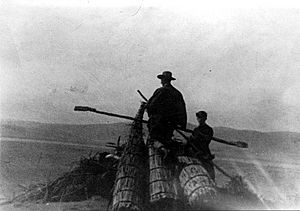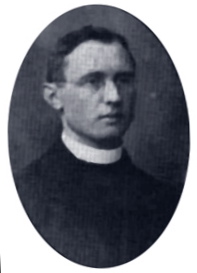Martin Gusinde facts for kids
Martín Gusinde (born October 29, 1886, in Breslau, died October 10, 1969, in Mödling, Austria) was an Austrian priest and a special kind of scientist called an ethnologist. Ethnologists study different cultures and peoples. He became famous for his work with the native groups living in Tierra del Fuego, a region at the southern tip of South America. He was one of the most important anthropologists in Chile in the early 1900s.
Martín Gusinde's Career
In 1900, Martin Gusinde joined a missionary group called the Divine Word Missionaries. He began his higher education in 1905 in St. Gabriel, near Vienna. After becoming a priest in 1911, Gusinde traveled to Chile. He worked as a teacher from 1912 to 1913. After that, he joined the Ethnographic Museum in Santiago de Chile and worked with another famous scientist, Max Uhle. By 1918, Gusinde became a head of department at the museum.

Between late 1918 and 1924, Gusinde made four important research trips to Tierra del Fuego. His goal was to learn about the different native groups there, especially the Yamana and Selk'nam (also known as Ona). These groups had faced many challenges. New people arriving in the area had pushed them from their lands. Also, diseases brought by these new people caused many of the native people to get sick and die because they had no natural protection against them.
Gusinde spent a total of 22 months in Tierra del Fuego. He was even allowed to take part in the special initiation rites of the groups he studied. He also recorded the songs and chants of the native peoples. These recordings are very important because they are the only audio recordings that still exist of the Tierra del Fuegan Indians.
In 1926, Gusinde earned his doctorate degree in anthropology from the University of Vienna. Anthropology is the study of human societies and cultures. He also helped to publish a Yamana-English dictionary in 1933. This dictionary was based on notes from an earlier missionary named Thomas Bridges.
In the mid-1930s, Gusinde traveled to the Congo region in Africa to study the pygmies.
Later in his life, from 1949 to 1957, Gusinde worked as a professor at The Catholic University of America in Washington, DC. In 1956, he went on another trip to study the Ayom pygmies in New Guinea. From 1959 to 1960, he taught at Nanzan University in Nagoya, Japan.
Martín Gusinde finished his career by researching, lecturing, and teaching at the Mission St. Gabriel in Maria Enzersdorf, Vienna. He passed away in Mödling on October 10, 1969.
Martín Gusinde's Legacy
To honor Martín Gusinde and his important work, the Martin Gusinde Anthropological Museum was built in Puerto Williams, Chile. This museum shares information about his studies of the Tierra del Fuego Indians. Streets have also been named after him, like Padre Martin Gusinde street in Padre Hurtado, Santiago, Chile, and Martin-Gusinde-Gasse in Maria Enzersdorf, Austria.
Awards and Honors
- 1952: Karl Renner Prize
- 1958: Austrian Decoration for Science and Art
- 1966: Grand Silver Medal with Star for Services to the Republic of Austria
- Honorary Ring of Vienna
See also
 In Spanish: Martin Gusinde para niños
In Spanish: Martin Gusinde para niños


